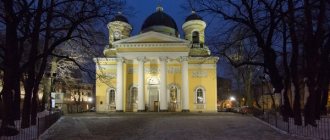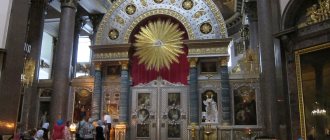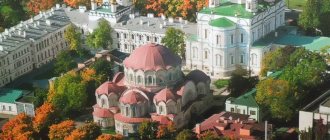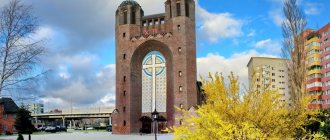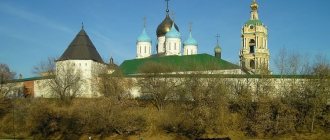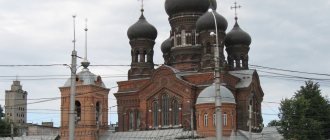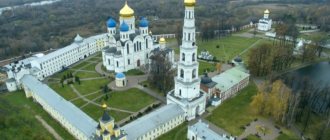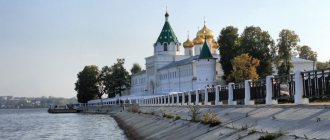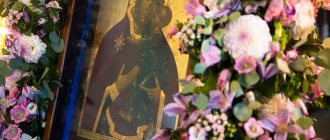The Gatchina Intercession Cathedral (also called the Cathedral of the Intercession of the Blessed Virgin Mary) is an active Orthodox church, along with the St. Paul Cathedral, one of the cultural heritage sites of the Russian Federation. It is the largest church in the Leningrad region, consecrated in honor of the Mother of God.
The Intercession Cathedral in Gatchina has a rich history: it survived two wars, a difficult period of persecution during the Soviet years, closure and a long restoration.
In 2014, the cathedral solemnly celebrated its centenary.
Now the cathedral is a majestic snow-white temple with golden stars and blue domes, which is one of the attractions of Gatchina, loved by both local residents and tourists.
The interior of the temple is spacious, beautiful and has a lot of light: in clear weather, the rays of the sun penetrate through the large stained glass windows and leave colored reflections on the floor. Among the church utensils there are icons and caskets with pieces of the relics of saints.
According to reviews from tourists and parishioners, a sincere atmosphere reigns in the temple, festive services are held beautifully and solemnly, accompanied by the singing of the choir.
© Vyacheslav Vertyanov
How to get there
Ioannovsky Convent on Karpovka is located in the central, historical part of the city, in the area popularly called “Petrogradka”. Getting here by car is not difficult. You can arrive from anywhere in St. Petersburg. The route will depend on where the trip starts. The monastery can also be reached by public transport.
The easiest way to get there is to use the metro. The monastery is located not far from the Petrogradskaya station.
You can walk from it. Walk to the monastery for about 10-15 minutes. Coming out of the metro, you need to turn right and walk along the avenue called Kamennoostrovsky. Having reached the Karpovka embankment, you need to cross the Silin Bridge, then turn left and walk along the embankment all the way to the monastery.
You can get there not only by metro, but also by other public transport:
- by tram number 340;
- by bus number 10;
- on minibus T234;
- by bus No. K 321;
- by bus number 25;
- by minibus K 98;
- by bus K 222.
Stops for this transport are located near the monastery, so it will be impossible to get lost.
Location
Many are interested in how to get to the monastery to venerate the relics of St. John of Kronstadt. It is located in St. Petersburg near the Petrogradskaya metro station on Naberezhnaya r. Karpovki, 45-36.
Note! Any city resident can answer the question of how to get there. You can get there by bus number 10, by tram number 40, and also by minibuses: K 98, K 222, K 321.
The monastery on Karpovka has its own official website on the Internet, where you can see the schedule of services. Also on the official website is the schedule of clergy in the Ioannovsky Monastery for the week, that is, for the current week.
Official website on the Internet
This is interesting! Schedule of services at the Church of Otrada and Consolation
Only nine clergy serve here:
senior priest - Archpriest Nikolai Belyaev; Archpriest. Georgy Ochkalov; prot. Mikhail Pshenichny; prot. Dimitry Galkin; prot. Vladimir Rozhdestvensky; archpriest. Alexander Sevastyanov; prot. Oleg Gavrilov; priest Alexander Nebieridze; hierodeacon Daniil Melnikov.
Divine services in the Ioannovsky Monastery on the Karpovka River are held every day: in the morning the Divine Liturgy is served, and in the evening - the All-Night Vigil. The start of services can be found in the schedule on the website.
Interesting! Schedule of services in the Church of St. Elijah the Prophet
The abbess of the monastery is now Abbess Lyudmila Voloshina. The monastery compound is located in the St. Petersburg region at the address: Vartemyagi village, Vsevolozhsk district, Toksovskoe highway, no. 5.
Story
Initially, the monastery was not built independently, but as a courtyard for another women's community. The construction site was consecrated in 1900. Construction began in the same year. In 1901, the main building of the complex was ready. The consecration of the lower temple took place immediately. It was decided to leave the monastery independent, and not as previously planned.
In 1902, the main temple, which occupies the 2nd and 3rd floors, was consecrated. From 1903 to 1908, construction of the monastery continued. Premises were built, which later formed an entire monastery complex. While construction was going on, John of Kronstatt contributed and helped. In 1908 he died and was buried in the basement of the main building.
Miracles of healing began to occur in the tomb. In 1909 alone there were more than 10 of them. In 1919, the monastery complex was captured by the Bolsheviks. They turned the monastery into a commune and opened a hostel there. The sisters lived there for another 3 years and then were evicted. They were soon arrested and deported to Kazakhstan.
In 1923, all the property of the monastery was confiscated. It was decided to liquidate the monastery. As a result, all buildings were transferred to the technical school. The entrance to the tomb of John of Kronstadt was walled up. The monastery complex was returned to the church only in 1989. At first it opened its doors as a courtyard of the Pukhtitsa monastery.
The entrance to the tomb of I. Kronstadt was bricked up. The first floor was vacated and again acquired the appearance of a temple. Renovations have begun throughout the complex. Soon the temple, located on the 1st floor, was consecrated and began to function. We managed to get it in order in just 2 weeks. The first service after restoration took place in November 1989.
The news that the monastery had been partially restored quickly spread, and a huge number of believers came to the first service. There were so many people that they could not all fit in the building. Many had to stay on the street. So that everyone could hear the progress of the service, speakers were installed that broadcast everything that was happening inside.
In 1991, the upper temple was also restored. In December of the same year, the monastery was declared stauropegial, that is, subordinate not to the local church authorities, but to the patriarch. Today the monastery has been completely restored and is functioning. Every day services are held here, and you can confess. On certain days the Sacrament of Baptism takes place. All-night vigils are held.
Architecture and exterior decoration
Ioannovsky Convent on Karpovka was built on an architectural scale. He is characterized by grace and severity in appearance. The architect who created the project and supervised the construction of the monastery is N. N. Nikonov. He served as a diocesan architect and was one of the best in his craft. N. Nikonov decided to erect a building in the neo-Byzantine style.
The project was approved by Emperor Nicholas II himself. St. John's Monastery is the very first building in Russia erected in this church architectural style. On the strict façade of the monastery there are horizontal stripes that resemble mixed Byzantine masonry. It is decorated with ceramics. The facade is also decorated with an icon of St. John of Kronstadt. It was installed already in the 21st century.
Today the building is black and white. But initially it was not like that. There were other colors in its decoration. N. Nikonov loved everything bright, so he also added bright accents to the monastery project. Initially, the monastery had cheerful, shiny domes painted blue, white and green. But, unfortunately, the multi-colored decoration has not been preserved; it has been gone for a long time.
History of the foundation of the monastery
Even before the creation of the St. Petersburg monastery, John of Kronstadt founded a convent in the Arkhangelsk province, in the place of his birth - the village of Sura. He took great care of his sisters and looked after them, and when a merchant donated a piece of land to Father John in St. Petersburg, the priest wanted to build a courtyard for his monastery and organized a fundraiser .
Ioannovsky Stavropegic Convent
St. John was extremely popular in all levels of society, and he found so many donors that instead of a modest farmstead of a rural monastery, one of the largest monasteries in the country appeared.
This monastery became famous for the grace and scope of its architecture. Construction began in 1900. The architect was Nikonov. He chose for his creation the so-called. neo-Byzantine style. The project was reviewed and approved by Nicholas II.
Father John consecrated the first church on the lower floor in 1901 in honor of his heavenly patron John of Rylsky. This monastery bears his name to this day (not the name of John of Kronstadt, as is sometimes mistakenly thought).
By 1903, the top two floors were completed. They housed the main temple of the twelve apostles with two chapels (the first - the Kazan Icon of the Mother of God, the second - St. Mary of Egypt and St. Andrew of Crete).
Construction work continued until 1908. New buildings appeared on the territory of the monastery - a residential building for the clergy and pilgrims, cells, an infirmary, workshops for icon painting and handicrafts. A tomb was made in the basement of the cathedral.
Ioannovsky Monastery 1900s
Interesting! Until his death in 1909, Saint John of Kronstadt was a priest and confessor in the monastery he built.
Read about the confessor of the monastery:
- Icon of the Holy Righteous John of Kronstadt
- Relics of John of Kronstadt
- Prayer to John of Kronstadt for drunkenness
He fell in love with her very much, considered her “his own” and asked to be buried in the monastery tomb. His will was carried out, and the tomb was made a temple, consecrated in honor of the patron saints of the father and mother of John of Kronstadt - the prophet Elijah and Saint Theodora.
Architectural ensemble
The monastery building does not stand alone. The monastery is a whole complex. First the temple was built. In 1903, a 5-story house was erected for the monastery servants and for people who wanted to live at the monastery. The facade of this living space is made in the same style as the main building - neo-Byzantine, only in a more simplified version.
In 1908, several more buildings appeared in the ensemble: workshops and an infirmary. Cells for the sisters (200 in number) were built. A tomb was built in the basement of the temple. John of Kronstadt, who soon died, is buried there. All buildings belonging to the monastery form a single whole, since they are connected to each other.
In 1911, the architectural ensemble was expanded again. The Seraphim Chapel appeared. There was a temporary wooden chapel on this site. But then it was removed and a new stone one, created according to the design of N. Nikonov, was installed in its place. It has not survived to this day. Perhaps her loss occurred due to the fact that she interfered with the construction of the bridge across Karpovka.
There is another chapel on the territory of the monastery - Pokrovskaya. You can see it if you approach the monastery at the place where Popova Street and Ioannovsky Lane intersect. It was built already in 2000. It is believed that it was erected to replace Serafimovskaya and it recreates its appearance, only it has a different name and is located in a different place.
There is another chapel on the territory of the complex - a cemetery. There is evidence that it was built during the First World War. The chapel is visible from the embankment. Until recently, the fence of the monastery was uninteresting, representing an ordinary fence made of reinforced concrete. Recently, the old fence designed by N. Nikonov was recreated. And the gates are now decorated with paintings.
Interior decoration
The inside of the monastery is decorated. The floor of the temple is made of ceramic tiles of different colors, which form interesting and intricate patterns. The walls are covered with ceramic tiles in 2 colors. The windows have beautiful, bright and colorful stained glass windows. The iconostases are made of oak. And the thrones and altars are made of white marble.
Don’t miss the most popular article in the section: Optina Pustyn Monastery - how to get there from Moscow, address, where it is located, history and interesting facts.
The main temple of the monastery - the Cathedral of the 12 Apostles - is located on the 3rd floor of the main building of the complex. A beautiful grand staircase leads there. There is not much gilding inside the temple; it does not look rich. The room is simple, monastic, but joyful and bright. It looks solemn. Its decoration looks especially beautiful during the day, in sunlight.
On the 1st floor there is the Church of St. John of Rila.
She is small, but cute and even graceful. Until recently, it was closed to the public, and only in 2016 it was opened. From here you can go down to the basement, where the tomb of John of Kronstadt is located. An iconostasis is installed behind the grave. To the left of it are the Royal Doors. The first abbess of the monastery, Schema-Abbess Angelina, also rests here.
How to get to the Intercession Cathedral in Gatchina
The Intercession Cathedral is located at the intersection of Krasnaya and Dostoevsky streets. 100 meters from the cathedral on Chkalova Street there is a public transport stop “Music School”, where buses No. 21, 431, 514, 517, 518, 521, 522, 523, 523a, 524, 525, 526, 527, 529 stop. 530, 533, 536, 537, 539, 540, 542, 543, coming from neighboring cities, towns and stations, as well as minibus No. 631, coming from the stop “Novatorov Boulevard (Dachny Prospekt)” in the south of St. Petersburg.
For those who plan to come to the temple by personal car, this can be done by turning from 25 October Avenue onto Revolyutsionny Lane, and then onto Krasnaya Street.
You can also get to the Gatchina Intercession Cathedral by using a taxi service, for example, one of the applications of companies such as Yandex. Taxi, Uber, Gett.
Video: Church of the Intercession, Gatchina
Shrines and relics of the monastery
Ioannovsky Convent has a collection of Orthodox shrines. Among them are icons, relics and parts of vestments. Anyone can join them.
The following shrines are kept in the monastery on Karpovka:
- vestments of St. John of Kronstadt;
- icon of St. John of Kronstadt;
- relics of St. John of Kronstadt;
- icon of the Great Martyr Panteleimon;
- parts of the monastic robe of the first abbess;
- particles of the belt and clothes of the Virgin Mary;
- icon of the Intercession of the Mother of God;
And also other shrines. The main shrines are kept in the underground tomb of John of Kronstadt. It is open every day. You can enter it after the end of the morning Liturgy and before the start of the evening service, that is, until 17:00. A prayer service in the tomb is served daily, after the end of the liturgy.
I. Kronstadsky received permission to be buried in the tomb of the Ioannovsky Monastery during his lifetime, several years before his death. The tomb is decorated quite richly. Funds for this were donated by novice Anna Lezhoeva, who later became a nun and treasurer here. Her relics are also kept in this monastery.
Initially, the iconostasis, next to which the tomb stands, was made of white marble. But during the Soviet years it was lost. It was restored from wood. The sisters and clergy of the monastery treat the relics, as well as pieces of clothing of the first abbess, with special trepidation. She was schema-abbess Angelina. Her worldly name is Anna. She was born in St. Petersburg in 1867.
She graduated from high school and after that got married. But fate decreed that tragic events occurred in her life. First her parents died, then her husband. Anna then decided to devote her life to serving the Lord. Mother was the devoted spiritual daughter of John of Kronstadt himself. All her life she fulfilled his wishes. He appointed her to lead the construction of the monastery.
She devoted all her strength to tripling the new monastery. When the monastery was built, she was awarded the position of abbess. For her work, mother was awarded many awards. The abbess was quiet, modest and humble. She was never strict with her sisters, did not punish. She spoke calmly to the guilty and knew how to calm them down without shouting.
She never reproached her, but she knew how to convey to the nun in a calm conversation that her action was wrong and unworthy. When the Bolsheviks came to power, the abbess was under investigation for a long time and died before her arrest - in 1927. She was buried in the Alexander Nevsky Lavra. Her modest grave became a place revered by believers.
After the Ioannovsky Monastery was restored, the sisters who were sent here to serve God wished that the remains of the first abbess be transferred to the monastery, which she led during her lifetime. Patriarch Alexy II gave them his blessing for this. At the end of October 1997, mother was transported to the tomb of the Ioannovsky Monastery.
One of the main shrines in the monastery is the icon of the Intercession of the Mother of God. The sisters took it from the church located at the Bolsheokhtinsky cemetery. It was old, almost completely colorless and required restoration. The figure of the Mother of God was barely visible on the canvas. The icon was brought to the St. John's Monastery and after Easter real miracles began to happen to the image of the Mother of God.
At first her face became brighter. Then colors appeared on it. Every day it became lighter, brighter, the colors more saturated. In the end, the icon was almost completely updated. In connection with this event, the Patriarch blessed the sisters and the abbess to transfer the image of the Intercession of the Mother of God and place it on public display so that everyone could venerate her.
Ioannovsky Convent. One of the main shrines is the icon of the Intercession of the Mother of God.
Every Friday, during services in the main church of the monastery, akathists sing before the icon. Both the sisters and parishioners especially revere her. Over time, it became clear that the image did not end up in the Ioannovsky Monastery by accident. On the reverse side there was an inscription that said that the author of the icon was John Smirnov, a priest from the Polish city of Lesna.
The monastery in which he served was under the patronage of John of Kronstadt. During the German War, the nuns of the Lesna monastery hid in St. Petersburg. They were sheltered by the sisters of the Ioannovsky Monastery. They spent the entire war here and after it ended they returned home.
How the icon painted by a priest from Poland came to St. Petersburg - by whom and when it was brought from Poland - is still a mystery. How many years she was in Russia is also unknown. But miraculously she ended up in a monastery built under the leadership of John of Kronstadt. The abbess, sisters and clergy see God’s providence in this.
It became known that the icon was kept for many years by a nun from a church located at the Bolsheokhtinsky cemetery, from where it arrived at the monastery.
That nun's name was Agapit. Despite the fact that the monastery was closed for a long time, it was ruined, but the spiritual connection of its contemporary nuns and sisters of past generations is not interrupted, thanks to the shrines stored in the complex on the embankment of the Karpovka River.
Shrines of the monastery
The monastery houses many shrines. In addition to the tombstone of Righteous John of Kronstadt, erected at the site of his burial, there are many icons with particles of relics: the Great Martyr Panteleimon, Blessed Matrona, St. Luke of Voino-Yasnensky, Peter and Fevronia of Murom, etc.
Temple-burial vault of St. John of Kronstadt
There is a fragment of the Holy Cross, particles of the clothes of the Lord and the Blessed Virgin Mary. The temple icon of the Intercession of the Mother of God, with which the miracle of renewal occurred, is also venerated.
The priestly vestments of John of Kronstadt are kept in the tomb; they are also revered as a shrine.
Mentors
Abbess of the monastery Lyudmila Voloshina. Born in 1953. In 1970 she came to Moscow to study. After training, she remained in the capital. In 1980 she became a novice. In 1990, she was tonsured and named Lyudmila. In 1992, the Patriarch blessed her to serve in the Ioannovsky Monastery, which was on the path of restoration.
There she received the appointment of treasurer. In 2013, she was appointed abbess of this monastery, and in 2014, Patriarch Kirill elevated her to the rank of abbess.
Priests at the monastery:
- Nikolai Belyaev (senior priest);
- Alexander Sevostyanov (priest);
- Daniil Melnikov (hierodeacon) and others.
Abbesses of the monastery
In different years of the monastery’s existence, the abbess were:
- Mother Angelina. Spiritual daughter of Father John. With his blessing, she supervised the construction of the monastery on Karpovka, and became its first abbess. Together with other sisters, she came under Soviet repression. She remained their spiritual mentor until her death in 1927. Even when the nuns were expelled from the monastery, she continued to provide them with spiritual care and preserved the community. She was under investigation and was supposed to be arrested, but she died shortly before that.
- Mother Seraphim. The first abbess of the monastery revived after the period of Soviet power. Appointed abbess in 1991. During her reign, all the colossal restoration work was done. In 2006 she received an award for her work in restoring the monastery. She died in 2013.
- Mother Lyudmila. The third abbess of the St. John's Monastery. He has been leading the monastery since December 2013.
Service schedule, operating hours
The monastery is open to visitors from 8:00 in the morning until approximately 19:30 in the evening (until the end of the evening service). Worship services are held every day.
Schedule:
| Day of the week | Time | What is happening | Note |
| Monday through Friday | 8:20 | Morning Liturgy | On the days of the Twelve Feasts, morning services are held at 9:00, and confession at 8:30 |
| Monday through Friday | 8:15 | Confession | |
| Sunday | 9:00 | Morning Liturgy | |
| Sunday | 8.30 | Confession | |
| Daily | 17:00 | Evening Worship | |
| Daily | After the Liturgy | Prayer services | |
| Daily | After the end of the Liturgy | Funeral services | |
| Wednesday | 12:00 | Baptism | On some holidays the Sacrament of Baptism is not performed. Which ones specifically, it is better to check on the monastery website. |
| Friday | 12:00 | Baptism | |
| Saturday | 14:00 | Baptism | |
| Sunday | 13:00 | Baptism | |
| Saturday | 12:30 | Conversations with those wishing to be baptized | |
| Monday | 17:00 | All-night vigil | |
| Wednesday | 17:00 | All-night vigil | |
| Thursday | 17.00 | All-night vigil | |
| Saturday | 17.00 | All-night vigil |
The schedule of services is subject to change. You can find out more on the monastery website. There you can also see on what days which of the monastery’s clergy perform rituals.
Visiting rules
Ioannovsky Convent on Karpovka should be visited, following the strict rules established by the Orthodox Church. Before entering, you need to make the sign of the cross three times. It is unacceptable to come to the monastery in shorts and a T-shirt, in breeches or in a tracksuit. A man should wear trousers, and a woman should wear a long skirt or dress.
Clothes must be clean, tidy and closed. Necklines, deep cutouts on the back or long slits on skirts are unacceptable for women. You should also not wear a short skirt or open-shoulder clothing. A man entering the temple must remove his headdress.
A woman, on the other hand, needs to cover her head. If a woman did not plan a trip to the temple in advance and ended up wearing inappropriate clothes, then she can use a skirt and a scarf, which should be taken at the entrance to the monastery and returned back when leaving it.
If you want to venerate the shrines, it is better to come to the temple in advance before the start of the service. Decorative cosmetics that can leave marks on icons after a woman touches them should not be used. In the monastery it is not customary to talk loudly or gesticulate too actively. You shouldn’t talk about worldly things or discuss problems within its walls.
Joking and laughing are also inappropriate. During the service, your mobile phone must be turned off or the sound must be turned off. You must behave calmly, modestly and quietly. You cannot run around the monastery territory or turn on music. Smoking and swearing are prohibited. The monastery must be kept clean. You cannot enter the territory of the monastery while intoxicated.
Children should not be left unattended or allowed to make noise or play in the monastery. You can enter the monastery with animals, as well as visit economic and residential premises only after receiving a blessing from the Mother Superior. It is strictly forbidden to go into the sisters’ cells.
You can take videos and photographs outside without any hindrance. Filming inside the premises during the service is prohibited. You can do this before or after the end of the service, but quietly and without disturbing anyone. It is also forbidden to photograph or film the sisters living in the monastery. You can't hug sisters.
You can give them gifts only with the blessing of the abbess. People who find themselves at the monastery for the first time often break the rules. But, as a rule, they are forgiven for their mistakes and given parting words for the future. Although it is better not to make mistakes and prepare in advance for visiting monasteries by studying the rules.
Patronal holidays
Each monastery has its own holidays. There are, of course, also in the St. John’s Monastery.
Patronal feast days of the monastery on Karpovka:
| date | Holiday |
| January 2 | memory of John of Kronstadt |
| June 14 | glorification of John of Kronstadt |
| July 13 | Cathedral of the 12 Apostles |
| August 31 | memory of John of Rylsky |
| September 30th | Day of Saints Faith, Hope, Love and Sophia |
| October 14 | cover of the Virgin Mary |
| Nov. 1 | birthday of John of Kronstadt |
Interesting facts about the monastery
Ioannovsky Convent on Karpovka was originally supposed to become a courtyard of another convent. But when the construction was completed, it received the status of a monastery. The building on Karpovka is a monument; it is included in the register of cultural heritage.
The monastery was founded by John of Kronstadt. But the monastery received its name in honor of John of Rylsky, who was its spiritual teacher. In 1923, the monastery was closed, the nuns were arrested and expelled. The building housed a commune as well as a dormitory. The church building was returned only in 1989. There is a Sunday school at the monastery.
Cathedral of the Intercession of the Blessed Virgin Mary today
Today the following work in the Intercession Cathedral:
- Sunday school for children;
- Bible school for adults, offering a course of lectures on Bible study with the opportunity to discuss complex issues of exegesis;
- Orthodox youth club, the purpose of which is to unite the Orthodox youth of Gatchina and communicate;
- children's choir;
- a spiritual and educational center that organizes various events on the territory of the temple, including concerts, educational classes (learning the Church Slavonic language, the basics of photography), poetry evenings, exhibitions of photographs and drawings.
Intercession Cathedral in Gatchina on Google Maps panoramas
Information for visitors
A visit to the monastery will be interesting for believing Orthodox pilgrims. But ordinary tourists who are interested in architecture also often come here. Often the monastery becomes one of the points on a sightseeing tour of the city, which includes a visit to the Botanical Garden, Karpovka embankment and the I. Pavlov University of Medicine.
You can enter the monastery from 8 a.m. until the end of the evening service. There is no refectory or hotel for pilgrims and tourists at the monastery. Guests can inspect the shrines and decorations of the monastery on their own or with their guide. Priests and nuns do not give tours.
There is a church shop at the monastery where you can buy inexpensively:
- candles;
- icons;
- mallow;
- pectoral crosses;
- amulet;
- church literature and so on.
You can also buy delicious pies on the territory of the monastery. Ioannovsky Convent is a special place where peace, quiet and tranquility reign. At the monastery on Karpovka you can attend a service or talk with the holy father. People come here to pray and venerate the shrines. You can also order services, or just go to this holy place to look and soak in the atmosphere.
Author: Ariadna Lynnik
Article design: Ilchenko Oksana
Temples
Among the monastery churches there are:
- Cathedral of the Resurrection of the Word,
- temple in the name of the Athos Icon of the Mother of God “Consolation and Consolation”,
- Church of the Entry into the Temple of the Blessed Virgin Mary,
- Church of the Three Saints,
- house Temple of Seraphim Vyritsky,
- temple of the origin of the honorable trees of the Life-giving Cross of the Lord,
- Temple of the Appearance of the Mother of God to Sergius of Radonezh,
- Church of the Holy Trinity,
- Isidorovskaya bell tower,
- chapel in the name of Sergius of Radonezh and St. Equal-to-the-Apostles Nina,
- Kazan church.
There is also a Novodevichy cemetery on the territory of the monastery. A large number of prominent people, poets, as well as those who left their mark on the history of Russia are buried there.
